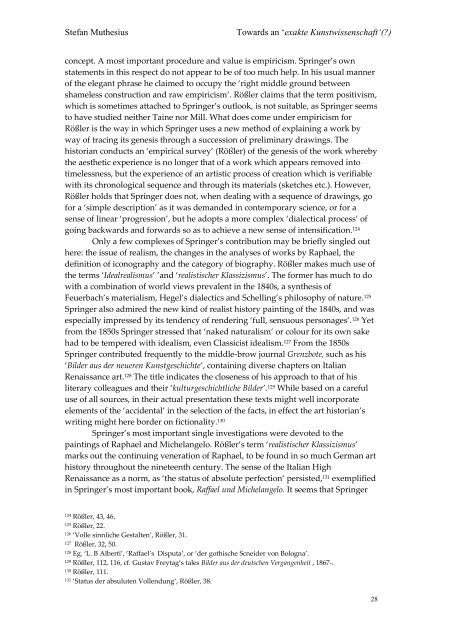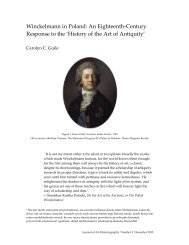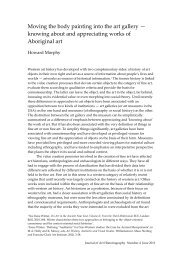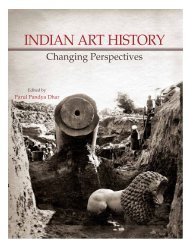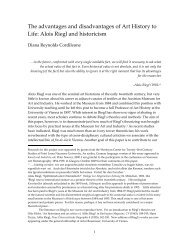9/SM1 - Journal of Art Historiography
9/SM1 - Journal of Art Historiography
9/SM1 - Journal of Art Historiography
Create successful ePaper yourself
Turn your PDF publications into a flip-book with our unique Google optimized e-Paper software.
Stefan Muthesius<br />
Towards an ‘exakte Kunstwissenschaft‘(?)<br />
concept. A most important procedure and value is empiricism. Springer’s own<br />
statements in this respect do not appear to be <strong>of</strong> too much help. In his usual manner<br />
<strong>of</strong> the elegant phrase he claimed to occupy the ‘right middle ground between<br />
shameless construction and raw empiricism’. Rößler claims that the term positivism,<br />
which is sometimes attached to Springer’s outlook, is not suitable, as Springer seems<br />
to have studied neither Taine nor Mill. What does come under empiricism for<br />
Rößler is the way in which Springer uses a new method <strong>of</strong> explaining a work by<br />
way <strong>of</strong> tracing its genesis through a succession <strong>of</strong> preliminary drawings. The<br />
historian conducts an ‘empirical survey’ (Rößler) <strong>of</strong> the genesis <strong>of</strong> the work whereby<br />
the aesthetic experience is no longer that <strong>of</strong> a work which appears removed into<br />
timelessness, but the experience <strong>of</strong> an artistic process <strong>of</strong> creation which is verifiable<br />
with its chronological sequence and through its materials (sketches etc.). However,<br />
Rößler holds that Springer does not, when dealing with a sequence <strong>of</strong> drawings, go<br />
for a ‘simple description’ as it was demanded in contemporary science, or for a<br />
sense <strong>of</strong> linear ‘progression’, but he adopts a more complex ‘dialectical process’ <strong>of</strong><br />
going backwards and forwards so as to achieve a new sense <strong>of</strong> intensification. 124<br />
Only a few complexes <strong>of</strong> Springer’s contribution may be briefly singled out<br />
here: the issue <strong>of</strong> realism, the changes in the analyses <strong>of</strong> works by Raphael, the<br />
definition <strong>of</strong> iconography and the category <strong>of</strong> biography. Rößler makes much use <strong>of</strong><br />
the terms ‘Idealrealismus’ ’and ‘realistischer Klassizismus’. The former has much to do<br />
with a combination <strong>of</strong> world views prevalent in the 1840s, a synthesis <strong>of</strong><br />
Feuerbach’s materialism, Hegel’s dialectics and Schelling’s philosophy <strong>of</strong> nature. 125<br />
Springer also admired the new kind <strong>of</strong> realist history painting <strong>of</strong> the 1840s, and was<br />
especially impressed by its tendency <strong>of</strong> rendering ‘full, sensuous personages’. 126 Yet<br />
from the 1850s Springer stressed that ‘naked naturalism’ or colour for its own sake<br />
had to be tempered with idealism, even Classicist idealism. 127 From the 1850s<br />
Springer contributed frequently to the middle-brow journal Grenzbote, such as his<br />
‘Bilder aus der neueren Kunstgeschichte’, containing diverse chapters on Italian<br />
Renaissance art. 128 The title indicates the closeness <strong>of</strong> his approach to that <strong>of</strong> his<br />
literary colleagues and their ‘kulturgeschichtliche Bilder’. 129 While based on a careful<br />
use <strong>of</strong> all sources, in their actual presentation these texts might well incorporate<br />
elements <strong>of</strong> the ‘accidental’ in the selection <strong>of</strong> the facts, in effect the art historian’s<br />
writing might here border on fictionality. 130<br />
Springer’s most important single investigations were devoted to the<br />
paintings <strong>of</strong> Raphael and Michelangelo. Rößler’s term ‘realistischer Klassizismus’<br />
marks out the continuing veneration <strong>of</strong> Raphael, to be found in so much German art<br />
history throughout the nineteenth century. The sense <strong>of</strong> the Italian High<br />
Renaissance as a norm, as ‘the status <strong>of</strong> absolute perfection‘ persisted, 131 exemplified<br />
in Springer’s most important book, Raffael und Michelangelo. It seems that Springer<br />
124<br />
Rößler, 43, 46.<br />
125<br />
Rößler, 22.<br />
126<br />
‘Volle sinnliche Gestalten’, Rößler, 31.<br />
127<br />
Rößler, 32, 50.<br />
128<br />
Eg. ‘L. B Alberti’, ‘Raffael’s Disputa’, or ‘der gothische Scneider von Bologna’.<br />
129<br />
Rößler, 112, 116, cf. Gustav Freytag‘s tales Bilder aus der deutschen Vergangenheit , 1867-.<br />
130<br />
Rößler, 111.<br />
131<br />
‘Status der absuluten Vollendung’, Rößler, 38.<br />
28


